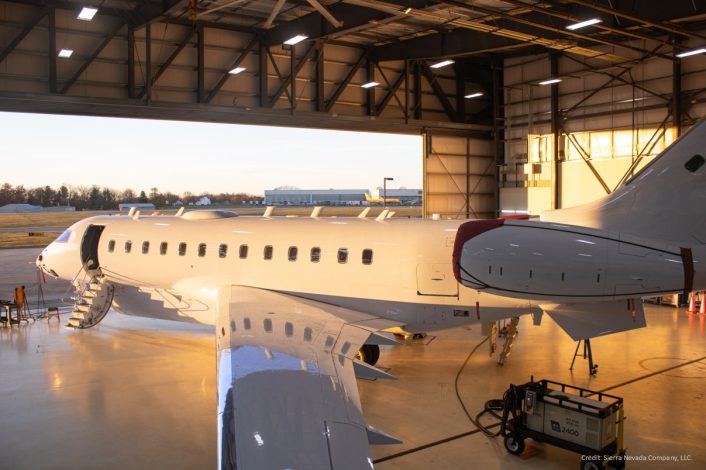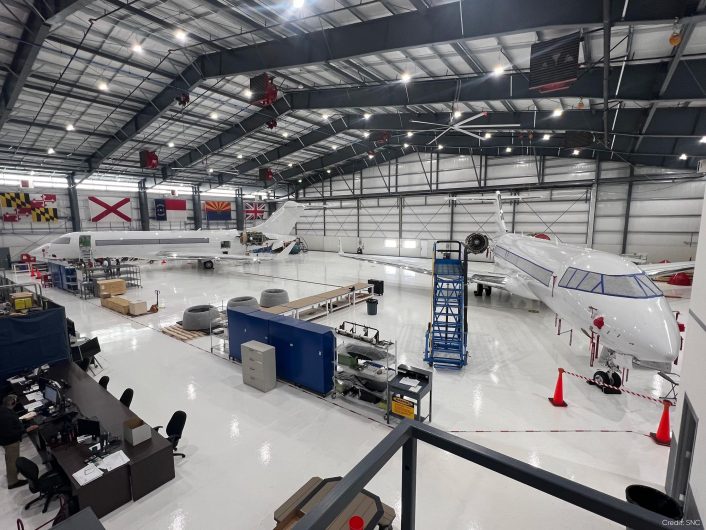The maiden flight of RAPCON-X marks a significant step forward for the U.S. Army’s ATHENA program, showcasing the future of adaptive ISR capabilities to address evolving global threats.
Sierra Nevada Corporation (SNC) has achieved a major milestone with the inaugural flight of the new RAPCON-X aerial intelligence, surveillance and reconnaissance (A-ISR) aircraft. Developed as part of the U.S. Army’s Theater Level High-Altitude Expeditionary Next Aerial-Signals Intelligence (ATHENA-S) program, the new jet based on the Bombardier Global 6500 aircraft will enhance battlefield situational awareness through advanced high-altitude sensing capabilities in multi-domain operations.
In fact, the service selected SNC in 2023 to provide two contractor-owned, contractor-operated (COCO) ISR aircraft for the ATHENA-S program, which will serve as a prototyping effort ahead of fielding a high-altitude ISR fleet. SNC converted the Global 6500 to the Rapidly Configurable To Any Mission-X (RAPCON-X) configuration at its facilities in Hagerstown, Maryland.
This morning @SierraNevCorp flew the first flight of its RAPCON-X aircraft, the heavily modified Global 6500 it is developing for the US Army’s ATHENA program.
I was on hand as the fully integrated aircraft took off on a brisk morning in Hagerstown pic.twitter.com/pQm0wfXmHD
— Brian Everstine (@beverstine) November 21, 2024
RAPCON-X was designed using model-based systems engineering (MBSE), said the company, significantly reducing the time required to integrate new and different systems and capabilities. The aircraft features a functional mission interior that can be easily reconfigured for specific mission requirements without costly aircraft redesign.
“SNC’s RAPCON-X team worked tirelessly to create an open architecture, aerial ISR solution that gives the warfighter the advantage required to win the near-peer fight,” said Josh Walsh, vice president of programs for Mission Solution and Operations. “I am extremely proud of our workforce and the progress we’ve made. This flight is proof of SNC’s readiness to support these critical customer missions and our ability to rapidly configure and deploy mission-specific solutions.”
RAPCON-X completed its first flight yesterday! This milestone is a significant step forward for the A-ISR platform, which has been selected for the U.S. Army’s Theater Level High Altitude Expeditionary Next Airborne ISR (ATHENA) project. #ICYMI #TeamSNC https://t.co/lV6v6kT5Rs pic.twitter.com/OMrHM0AQhh
— Sierra Nevada Corporation (@SierraNevCorp) November 22, 2024
RAPCON-X
The RAPCON-X is a highly versatile ISR platform, according to SNC, designed to deliver superior operational capabilities in contested and complex environments. The platform is meant to address the growing demand for multi-domain ISR capabilities, essential for maintaining strategic advantages in a rapidly shifting geopolitical landscape.
SNC’s press release emphasized the aircraft’s adaptability, stating “The RAPCON-X represents the future of ISR, delivering unparalleled capabilities to our military and intelligence partners.” The program reflects a growing need for platforms that seamlessly integrate air, land, sea, cyber, and space capabilities into cohesive strategies, enhancing decision-making and operational effectiveness.
In its baseline configuration, RAPCON-X can collect and process signals intelligence, electro-optical reconnaissance and ground moving-target signatures. It also includes key technologies such as the proprietary SNC TRAX software that connects RAPCON-X with all net-enabled platforms in the battlefield, says the company.
SNC has designed the aircraft for rapid configurability, meaning the aircraft can be swiftly adapted to specific recon missions by quickly switching out on-board equipment to match tactical needs – particularly for higher altitudes and longer endurance. The company has also said the technology of RAPCON-X can easily be scaled to other types of aircraft, including the Bombardier Challenger 650 and King Air 350ER aircraft.
SNC also says the open architecture mission equipment package and easily configured mission fairing allow for rapid mission modification without aircraft redesign. This design eliminates OEM and vendor lock, adds the company, allowing for ‘best-of-breed mission equipment’. The digital modeling also allows to reduce the time required to integrate new systems as they are developed and become available.
Among the key features of the aircraft are high altitude, endurance and long range. In fact, RAPCON-X can operate above 45,000 feet and can sustain missions for over 14 hours, providing greater persistence for long-duration ISR operations, with a ferry range which exceeds 6,000 nautical miles, enabling global reach.
Also, the contractor-owned, contractor-operated (COCO) model offers an efficient and cost-effective approach for militaries looking to acquire ISR capabilities without the logistical burden of ownership. This goes hand-in-hand with the design which supports operations in peer-to-peer and near-peer environments without requiring extensive ground support, allowing higher deployment readiness.

ATHENA-S
This RAPCON-X platform was developed as part of the Army’s Theater Level High-Altitude Expeditionary Next Aerial-Signals Intelligence (ATHENA-S) initiative, which aims to enhance battlefield situational awareness through advanced high-altitude sensing capabilities. The program is part of the Army’s broader modernization strategy, including the forthcoming High Accuracy Detection and Exploitation System (HADES).
The ATHENA program represents the U.S. Army’s push for enhanced ISR capabilities in multi-domain operations. With adversaries adopting more sophisticated electronic warfare and anti-access/area denial (A2/AD) strategies, traditional ISR platforms are becoming less effective.
ATHENA aims to close these gaps by integrating advanced sensing technologies capable of providing real-time, actionable intelligence. The platform also provides a critical interim capability while HADES continues development, ensuring uninterrupted ISR coverage.
There are currently two main ATHENA programs, ATHENA-R and ATHENA-S, focused on Radar and Signals Intelligence, respectively. In 2023 the U.S. Army selected L3Harris and MAG Aerospace for ATHENA-R and SNC for ATHENA-S.
As mentioned, the two ATHENA-S aircraft will be offered to the U.S. Army as a contractor-owned, contractor-operated (COCO) ISR capability, including pilots, flight operations and logistics support. While the aircraft were directly acquired by SNC, most of the sensors will be provided by the government, including electronic and communications intelligence systems.

Implications for defense
The development of RAPCON-X reinforces the shift toward modular, scalable ISR solutions that support both strategic and tactical objectives. Its role in the ATHENA program also exemplifies the increasing importance of multi-domain integration for modern defense strategies.
With interoperability as a core feature, the platform ensures seamless collaboration with allied forces, enhancing coalition ISR capabilities. This is particularly crucial in contested regions where real-time intelligence sharing can influence outcomes.
The COCO model adopted with RAPCON-X and ATHENA offers an efficient and cost-effective approach for militaries looking to acquire ISR capabilities without the logistical burden of ownership. The adoption of a commercial derivative aircraft not only offers the reliability and endurance of the Bombardier Global 6500 airframe, but also a higher supportability and deployability due to its global support network.
The platform’s interoperability and open architecture align with emerging trends in defense procurement, emphasizing cost-effectiveness and rapid adaptability. As the ATHENA initiative progresses, RAPCON-X serves as a prime example of how industry partnerships can address immediate operational needs while paving the way for future technological advancements.









